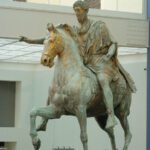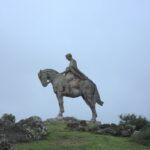“Equestrian statues have always served, through the centuries, a kind of epic purpose.”
Although Washington, D.C., is a city known for its statuary, the most compelling – and the most admired – are the statues of a horse and its rider. There are over 20 such statues in the District (more than any other American city) and they represent not just Americans, but foreigners and even ideals.

A popular misconception about equestrian statues is that the hoof placement of the horse is symbolic of how the rider died. It is said that two hooves in the air signifies that the rider died in battle. One hoof in the air signifies that the rider was wounded in battle. All hooves on the ground signifies that the rider was unwounded in combat. This is not true, especially since not all equestrian statues depict military leaders. There is a group of equestrian statues where this is mostly true – the equestrians at the Gettysburg battlefield – but even then there are outliers. The hoof placement of the horse is merely a reflection of the artist’s vision.
The oldest equestrian statue in the United States is in Lafayette Park in front of the White House and is of president – and hero of the Battle of New Orleans – Andrew Jackson. The horse has both hooves in the air, and rather than being a statement on how the rider lived or died, it is a reflection of the skill of the artist to balance the aesthetics of a rearing horse with the physics of balancing it on only two legs.

The largest group of equestrian statues in Washington is that of Civil War generals, with nine sculptures. The first to be erected was that of General Winfield Scott in 1874. The last was President Ulysses S. Grant’s in 1922. General Logan’s statue is the only one in the city with a bronze base. General Thomas’s equestrian is considered one of the best in the city, while General Scott’s is considered one of the worst.
There are four equestrians of Revolutionary War generals, with George Washington appearing twice, once in Washington Circle and the other at the National Cathedral. Nathanael Greene’s equestrian in Stanton Park fell off its base in the summer of 1930. Casimir Pulaski’s has been in Freedom Plaza since 1910. Bernardo de Gálvez doesn’t quite fit into this group but he did fight against the British in the Revolution, conquering Florida and making the fight easier for American soldiers.

George Washington and Simón Bolívar are the only individuals to have two equestrian statues in D.C. Bolívar’s are located on Virginia Ave. and at the Organization of American States building. Bolívar’s contemporary, José de San Martín, has an equestrian on Virginia Ave. as well.

The only equestrian statue in the city (and one of the few in the world) with a female rider is Joan of Arc in Meridian Hill Park. Joan’s sword was stolen in 1978 and was missing for over 30 years before being replaced in 2011. Other women featured on equestrian statues are Queen Elizabeth II in Canada and 19th century Indian nationalist Rani Lakshmibai in India. In the United States, Sacramento has Woman Being Attacked by a Buffalo on the pediment of their state capitol, and New York has an equestrian of Sybil Ludington, who is alleged to have made a ride similar to Paul Revere’s to warn American militiamen of approaching British troops.
There are two equestrians honoring religious leaders and both happen to be Methodists. The founder of Methodism, John Wesley, has an equestrian statue at the Wesley Theological Seminary. The other is of Reverend Francis Asbury in Mount Pleasant. Asbury was one of the men who established the Methodist Church in the United States.

Ideals are also memorialized in the equestrian statuary of Washington, D.C. Sacrifice and Valor are collectively called The Arts of War and they stand on the Washington side of the Arlington Memorial Bridge. Both feature a muscular, bearded man representative of Mars mounted on a horse. Each is accompanied by a woman with a shield. The Sacrifice statue features Mars holding a child in his arms while the woman looks back at him. The Valor statue has both figures facing forward with determined looks on their faces.

One of the oldest surviving equestrians in the world is of Roman emperor Marcus Aurelius in Italy. From 1974 to 2009 the equestrian of General José Artigas was the largest in the world at 18 meters tall. The current record holder is the equestrian of Genghis Khan in Mongolia. It stands 40 meters tall. That’s only about 130 feet, 20 feet short of the Statue of Liberty!
There are no plans to build any new equestrian statues in Washington. That’s due in large part to the replacement of the horse with the automobile, or in the case of warfare, the tank. Our generals and heroes no longer ride into battle mounted as they once did. Perhaps, when the World War One Memorial is built, it will feature General Pershing mounted on his horse Kidron. Personally, I would like to see an equestrian monument to Lieutenant Colonel Edwin P. Ramsey, who ordered the last American cavalry charge in the Philippines during WWII.
Resources used for this article:
https://en.wikipedia.org/wiki/Equestrian_statue
https://en.wikipedia.org/wiki/Category:Lists_of_equestrian_statues


